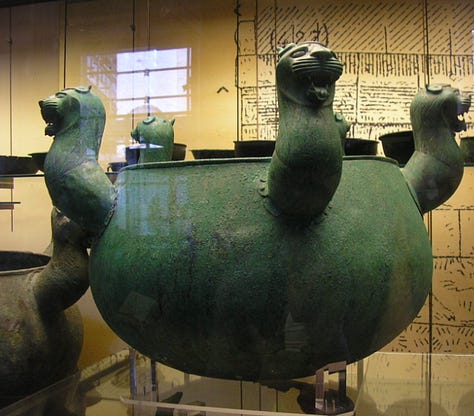Fresh Batch #57: The Etruscan City of Caere
Evidence that Briton, Norse, Indian, Chinese, African, & Mesopotamian Gods Originated in Italy
Grant mentioned the Regolini-Galassi Tomb and noted something that may prove an opposite direction of diffusion claimed by the status quo.
According to Wiki, the tomb known as the Regolini-Galassi tomb is one of the wealthiest Etruscan family tombs in Caere, an ancient city in Italy approximately 50–60 kilometres (31–37 mi) north-northwest of Rome. The tomb dates to between 650 and 600 BC, most likely in the 640s BC.
The tomb was discovered in 1836 in modern-day Cerveteri in an undisturbed condition and named after the excavators, general Vincenzo Galassi and the archpriest of Cerveteri, Alessandro Regolini. Both of these men had previous experience opening and excavating tombs in the area of Caere.
Grant wrote (The Etruscans, pp. 139, 140), “It was the Caeritans’ possession of saleable copper and iron that made it possible for them to afford these massive quantities of gold from the Greek markets of Pithecusae and Cumae. Moreover, they commissioned Greek gold-workers to fashion some of it for them, at those places, though they themselves also no doubt had their own local metal-workers operating in styles indistinguishable from those of the Greeks.
“The details of these gold bracelets and brooches and corsages and earrings were Greek, borrowed from a variety of near-eastern sources, but the forms and overall patterns (as well as the large dimensions) were Etruscan, or at least adjusted to suit Etruscan tastes; so was the extensive use of granulation and embossing techniques. They were not, it is true, unknown in Greece and the near east, but were refined to an extraordinary degree for this Etruscan market. The objects from the Regolini-Galassi tomb reveal clearly that the Etruscan gold jewelry achieved unsurpassable heights of skill. Indeed some of its secrets have still not been wholly solved today—the question, for example, of how the minute grains of gold were attached to the gold plate is not as fully answered as was thought.”







The tomb contains two burial chambers, located either side of a corridor 120 feet (37 m) long and 6 feet (1.8 m) wide. The lower portion of the tomb is cut into the tufa rock while the upper portion is built with square stone blocks, which has created an overhang resulting from the stone blocks extending one above the other. It is covered with a 150 feet (46 m) tumulus. The tumulus covers the entire structure giving it a facade of a monument. After the archaeological excavations of the tomb, the antiquities it contained were initially securely kept in a room in the residence of General Galassi, a key official of the papal army. The grave objects were subsequently sold to the Vatican. They can be viewed today in Gregorian Etruscan Museum.
Excavations at the site unearthed a royal woman buried in the end cell and a cremated man in the right-hand cell, and a wealth of items, including gold jewels, silverware, gilded and bronze ware, and a chariot. Also found on the bronze bed in an annex chamber was the body of one more person, whose identity has remained an unexplained mystery. Several of the items display seventh century BC Villanovan decorative motifs, including a great fibula, adorned with five tiny lions depicted striding across its surface, and a large 25 cm long plaque, decorated with depictions of animals of Eastern origin. The fibula has been acclaimed as masterful in technique, as have the Phoenician metal bowls.
If you’re interested in the missing key that solves many of the mysteries of this cultural diffusion, dive into The Holy Sailors (click the image).
Become a member to access the rest of this article and explore more of the Etruscan city-state Caere.
Keep reading with a 7-day free trial
Subscribe to Ancient History, Mythology, & Epic Fantasy to keep reading this post and get 7 days of free access to the full post archives.






